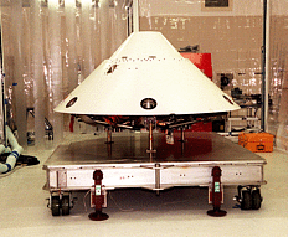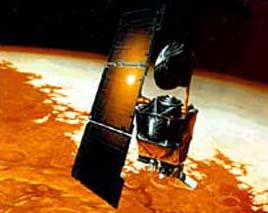Click on image for full size
Courtesy of NASA
Mars Polar Lander Coming Soon!
News story originally written on December 1, 1999
Cross your fingers! The Mars Polar Lander is scheduled to meet the Red Planet on December 3, 1999. Unlike the Mars Climate Orbiter, which would have orbited Mars, the Polar Lander will actually land on the surface. A successful mission will help ease the loss of the Climate Orbiter, which was due to a miscalculation in projectories.
"The spacecraft we lost was the simpler of the two to get to Mars," said Richard Zurek, NASA's chief scientist for the mission. "It should be easier to get into orbit than it is to land on Mars. So no one is underestimating the challenge of what we have to do here."
The Polar Lander will enter Mars' atmosphere and drop two probes, which will plummet towards the surface at high speeds. Each probe is the size of a grapefruit, and will travel at speeds near 400 miles per hour. If they survive the crash, the probes will burrow into the ground to search for water. Scientists are hoping this experiment will lead the way for future probe missions.
"The main idea is showing that these very small probes can be used someday to set up a network and make simultaneous measurements all over a planet," said Sue Smrekar, the mission's chief scientist at NASA's Jet Propulsion Laboratory.
Meanwhile, the Polar Lander will be gently floating down to the surface with the help of a parachute and two engines. If all goes as planned, the Polar Lander will soon be studying the south pole of Mars for signs of water. As of right now, scientists are not sure when, if ever, water was present on the planet.
"We expect to find more and more water down below the surface," said Paige, who leads a team based at the University of California at Los Angeles. "We'll dig deeper and better than any other mission's been able to do so far."














